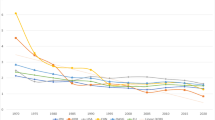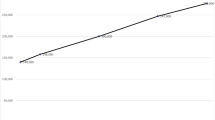Abstract
UK Higher Education has recently entered uncharted waters – this includes changes to the fee structures in England and ever increasing pressure to perform to measurables such as Key Information Sets, Destinations of Leavers in Higher Education data and a plethora of Key Performance Indicators. In this article, we highlight key findings from recent research regarding the status of women in the profession – with particular emphasis upon evidence that may suggest a gender divide in terms of research and teaching. We then go on to explore primary data from a number of sources to explore whether male and female academics in the UK have different priorities, and question to what extent recent reforms will exacerbate a ‘glass ceiling’ or ‘leaking pipeline’ and further challenge the diversity of the profession.
Similar content being viewed by others
Notes
The Global Gender Index employs a different methodology to HESA, though the HESA figure of 35 per cent for women academics in Politics and International Relations is just 3.5 per cent lower than the Index figure internationally for social sciences.
UK universities cluster into interest groups. University Alliance unites twenty-four HEIs in the United Kingdom that combine Science and Technology with a focus on delivering for the professions, business and the community. Other groups include, The Russell Group – twenty-four HEIs committed to world-leading teaching and research, and a collection of universities operating under the cluster Million+.
We acknowledge that this data is not as accurate as employment-level data but nevertheless argue that they are an important source of information regarding professional activity and engagement – particularly given preceding comments regarding networks.
The organisation conducted an online survey with a 20 per cent response rate (433 respondents out of a notional, 2,128 UK Departmental staff – though we have to acknowledge some slippage in accuracy of research population). Respondents appear ‘top heavy’ in terms of status/income compared with the UK academic community as a whole and we do not make any claims regarding ‘representativeness’.
The PSA UK has benefitted from the leadership of two women in its time. First was Professor Elizabeth Meehan (1993–1995) and then Professor Vicky Randall (2008–2011) – the latter championing the glaring lack of diversity in the profession (the most senior staff being overwhelmingly male and pale).
Of the 134 members of Universities UK, 19 have female executive heads (14 per cent). None are political scientists by training.
References
Akhtar, P., Fawcett, P., Legrand, T., Marsh, D. and Taylor, C. (2005) ‘Women in the political science profession’, European Political Science 4 (3): 242–255.
American Political Science Association (APSA). (2005) Women’s Advancement in Political Science, Washington DC: American Political Science Association.
Annesley, C. and Gains, F. (2014) ‘A reshuffle for women? Welcome, but underwhelming’, available at: http://blogs.lse.ac.uk/politicsandpolicy/a-reshuffle-for-women-welcome-but-underwhelming/, accessed 11 February 2015.
Bates, S., Jenkins, L. and Pflaeger, Z. (2012) ‘Women in the profession: The composition of UK political science departments by sex’, Politics 32 (3): 139–152.
Bennie, L. and Topf, R. (2003) ‘The PSA’s survey of the profession 2002’, PSA Annual Conference Paper, University of Leicester.
Briggs, J.E. and Curtis, S. (2012) ‘Learned societies analyse recruitment trends’, presented at PSA News 23 (3): 13–14.
Briggs, J.E. and Davies, C.T. (2014) ‘Politics: Popularity persists’, PSA News 25 (3): 16.
Campbell, R. and Childs, S. (2013) ‘The impact imperative: Here come the women’, Political Studies Review 11 (2): 182–189.
Centre for Women and Democracy. (2013) Sex and Power 2013: Who Runs Britain? London: Centre for Women and Democracy.
Childs, S. and Krook, M.-L. (2006) ‘Gender and politics: The state of the art’, Politics 26 (1): 18–28.
Dahlerup, D. (2010) ‘The development of gender and politics as a new research field within the framework of the ECPR’, European Political Science 9: 85–98.
Durose, C., Gains, F., Richardson, L., Combs, R., Broome, K. and Eason, C. (2013) Pathways to Politics, Manchester: Equality and Human Rights Commission.
European Commission. (2012) She Figures 2012: Gender in Research and Innovation, Brussels: European Commission Directorate General for Research and Innovation.
Grant, W. (2010) The Development of a Discipline: The History of the Political Studies Association, Oxford: Wiley Blackwell.
Grove, J. (2013) ‘Gender gap still yawns among the professoriate’, Times Higher Education, 2105: 6–7.
Harrison, L. and Sáez, L. (2009) ‘Political studies in the UK: A 21st century health check’, European Political Science 8 (3): 345–355.
Heward, C. and Taylor, P. (1992) ‘Women at the top in higher education: Equal opportunities policies in action?’ Policy and Politics 20 (2): 111–121.
Jarboe, N. (2013) ‘Women count: Leaders in higher education 2013’, available at: http://www.women-count.org, accessed 11 February 2015.
King, J. (2013) ‘Aston’s vindication of the rights of women to lead in their own way’, Times Higher Education, number 2106: 29.
Kupfer, A. (2003) ‘Justice in higher education’, Policy and Politics 31 (4): 447–464.
Maranto, C.L. and Griffin, A.E.C. (2011) ‘The antecedents of a “chilly climate” for women faculty in higher education’, Human Relations 64 (2): 139–159.
Sandler, B. (1986) The Chilly Climate Revisited: Chilly for Women Faculty, Administrators and Graduate Students, Washington DC: Association of American Colleges.
Times Higher Education. (2013) The global gender index, available at: http://www.timeshighereducation.co.uk/features/the-global-gender-index/2003517.article, accessed 11 February 2015.
Author information
Authors and Affiliations
Corresponding author
Rights and permissions
About this article
Cite this article
briggs, j., harrison, l. the status of women in uk political science. Eur Polit Sci 14, 105–115 (2015). https://doi.org/10.1057/eps.2015.7
Published:
Issue Date:
DOI: https://doi.org/10.1057/eps.2015.7




